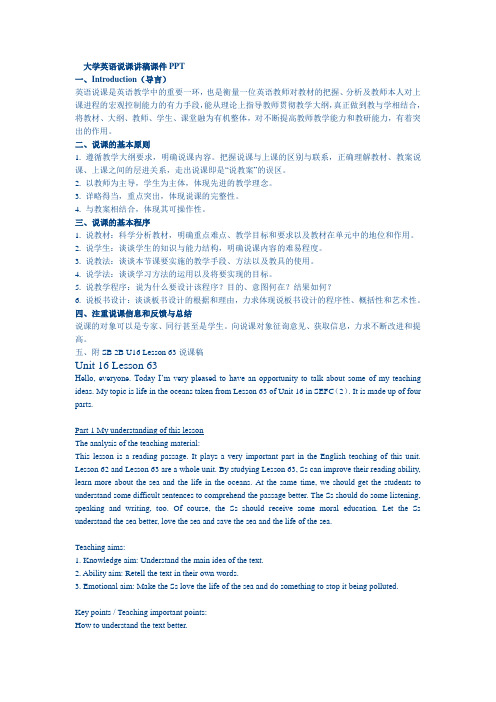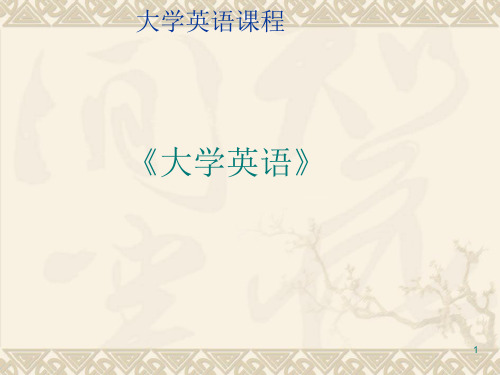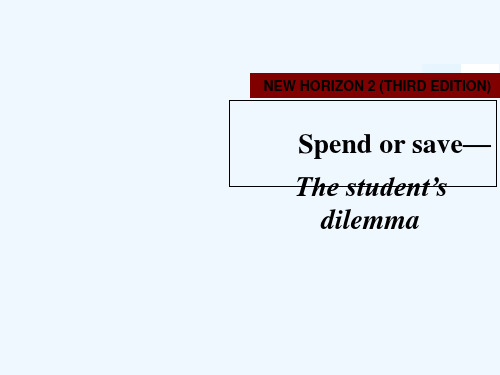大学英语说课ppt课件
大学英语课程说课ppt课件

01
Course Introduction and Objectives
Positioning of College English Curriculum
College English is a public basic course aimed at cultivating students' comprehensive English application abilities to meet the needs of China's social development and international communication.
Through the study of this course, students should be able to master certain English language knowledge, possess basic listening, speaking, reading, writing, and translation skills, as well as the ability to use English for daily communication and obtain professional information.
• Textbooks should be equipped with corresponding exercise books, listening materials, multimedia courseware and other teaching resources to facilitate students to learn independently and consolidate their knowledge.
大学英语说课讲稿课件PPT

大学英语说课讲稿课件PPT一、Introduction(导言)英语说课是英语教学中的重要一环,也是衡量一位英语教师对教材的把握、分析及教师本人对上课进程的宏观控制能力的有力手段,能从理论上指导教师贯彻教学大纲,真正做到教与学相结合,将教材、大纲、教师、学生、课堂融为有机整体,对不断提高教师教学能力和教研能力,有着突出的作用。
二、说课的基本原则1. 遵循教学大纲要求,明确说课内容。
把握说课与上课的区别与联系,正确理解教材、教案说课、上课之间的层进关系,走出说课即是“说教案”的误区。
2. 以教师为主导,学生为主体,体现先进的教学理念。
3. 详略得当,重点突出,体现说课的完整性。
4. 与教案相结合,体现其可操作性。
三、说课的基本程序1. 说教材:科学分析教材,明确重点难点、教学目标和要求以及教材在单元中的地位和作用。
2. 说学生:谈谈学生的知识与能力结构,明确说课内容的难易程度。
3. 说教法:谈谈本节课要实施的教学手段、方法以及教具的使用。
4. 说学法:谈谈学习方法的运用以及将要实现的目标。
5. 说教学程序:说为什么要设计该程序?目的、意图何在?结果如何?6. 说板书设计:谈谈板书设计的根据和理由,力求体现说板书设计的程序性、概括性和艺术性。
四、注重说课信息和反馈与总结说课的对象可以是专家、同行甚至是学生。
向说课对象征询意见、获取信息,力求不断改进和提高。
五、附SB 2B U16 Lesson 63说课稿Unit 16 Lesson 63Hello, everyone. Today I’m very pleased to hav e an opportunity to talk about some of my teaching ideas. My topic is life in the oceans taken from Lesson 63 of Unit 16 in SEFC(2). It is made up of four parts.Part 1 My understanding of this lessonThe analysis of the teaching material:This lesson is a reading passage. It plays a very important part in the English teaching of this unit. Lesson 62 and Lesson 63 are a whole unit. By studying Lesson 63, Ss can improve their reading ability, learn more about the sea and the life in the oceans. At the same time, we should get the students to understand some difficult sentences to comprehend the passage better. The Ss should do some listening, speaking and writing, too. Of course, the Ss should receive some moral education. Let the Ss understand the sea better, love the sea and save the sea and the life of the sea.Teaching aims:1. Knowledge aim: Understand the main idea of the text.2. Ability aim: Retell the text in their own words.3. Emotional aim: Make the Ss love the life of the sea and do something to stop it being polluted.Key points / Teaching important points:How to understand the text better.Teaching difficult points:1. Use your own words to retell the text.2. Discuss the pollution of the sea and how to save the sea.Something about the Ss:1. The Ss have known something about the sea and sea life through the Internet and other ways.2. They are lack of vocabulary.3. They don’t often use English to express themselves and communicate with others.4. Some Ss are not active in the class because they are afraid of making mistakes.Part 2 My teaching theories, methods and aidsBefore dealing with this lesson, I’ll do my best to carry out the following theories: Make the Ss the real masters in class while the teacher himself acts as director;Combine the language structures with the language functions; Let the students receive some moral education while they are learning the English language.Teaching method:Double activities teaching methodQuestion-and-answer activity teaching methodWatch-and-listen activityFree discussion methodPair work or individual work methodTeaching aids:1. a projector2. a tape recorder3. multimedia4. the blackboardPart 3. Teaching steps / proceduresI have designed the following steps to train their ability of listening, speaking, reading and writing, especially reading ability.The entire steps are:Greetings, Revision, Lead-in and preparation for reading, Fast reading(scanning), Listening, Intensive reading, Preparation for details of the text, Consolidation, Discussion, HomeworkStep 1 GreetingsGreet the whole class as usual.Step 2. Revision1. Ask students some questions to revise the last lesson(show them on the screen).a. How much salt do the oceans contain per thousand parts of water?(35 parts of salt. 3.5% by weight)b. What is coral? Why are corals not found in deep water?c. Why is the Dead Sea called the Dead Sea?2. Check the homework(made a survey about the sea or sea life by surfing the Internet or asking for help from other people). Through this part we can consolidate what they studied yesterday, communicate with others about their survery results and prepare for the new lesson.Step 3. Lead-in and preparation for readingShow them some pictures and let them talk each other, and then use the pictures about sea and life in the oceans to learn new words, for example, Antarctica, huge whale, sperm whale, squid and so on. Purpose: Arouse the students’ intere st of study.Bring in new subject: Life in the oceans.Step 4. Fast readingRead the passage as quickly as they can. I show the questions on the screen and let them get the main idea of each paragraph:1. Why can living things live in such oceans around the Antarctica?2. What does the whale feed on?3. What is the difference between the sperm whale and other whales?Method: Read the text individually, use question—and—answer activity.Purpose: Improve the students’ reading ability.Understand the general idea of each paragraph.Step 5. Listening(book closed)1. Listen to the tape then do an exercise(wb page 90, part 1)2. True or false exercise.(on the screen)Train the Ss’ listening ability and prepare for later exercises.Step 6. Intensive readingRead the passage carefully again and answer some detailed questions on the screen.1. How much does a whale eat at a time?2. Do all the whales feed on small fish?3. How deep can a sperm whale dive?It is also called depth reading or study reading. It means reading for detailed information.Purpose: Further understand the text (Train further reading ability)to find out some different sentences and details of the text.Step 7. Preparation for details of the text on the screen1. ...its heart slows to half its normal speed.slow-v. to become / make slower.2. ing sound wavePresent participle used as adverbial.3. provide sth. for sb.provide sb. with sth.4. at a time: each time5. grow to a length of...Purpose: Train the Ss’ ability of understanding and using laguage.Step 8. Consolidation1. Find out the topic sentences.2. Retell the passage according to the topic sentences.Purpose: I want to know if my students understand the whole text really and if they master what I mean to tell them in this class. What’s more, I want to let them have the ability of introducing and analyzing expression. At the same time, I will write down the topic sentences on the blackboard according to what the students find, so they can retell it easily.Step 9. DiscussionShow them some pictures about the polluted sea and many living things which are in danger and ask them: What are their opinions about it? In order to let them have free choice, I give them another topic: The sea is being polluted. What should they do?Purpose: I mean to give them emotional education. I give them multi-media pictures to arouse their interest of study and their love for life. I mean to make them realize: The sea is in danger!I teach them to do their best to help it and do something from now on. Everyone should do something to love and protect our home.Step 10. HomeworkWrite an article Saving the sea. I want to improve the ability of their writing. At the same time, train the ability of do-it-yourself and looking up the information by themseleves.Part 4. Blackboard designUnit 16 Lesson 63Topic Sentences:1. Some living things can live in Antarctica.(what)2. The whale feeds on small fish.(what)3. The sperm whale feeds on squid.(difference)Discussion:1. The whales are in danger. What’s your opinion about it?2. The sea is being polluted. What should we do?In my opinion, the blackboard design can reflect the teacher’s ability of mastering the text and leading the students to master the text easily.In this text, the design is not easy to write. I write the topic sentences on the blackboard in order to tell the students that this is of the importance in this class. The discussion is of the difficulty.I want to make the design inductive, instructive and artistic.。
大学英语课程说课(课堂PPT)

80学时
12
考核方式
➢ 评价项目多元化 语言应用能力、方法 能力、社会能力;学 习态度、综合素质
➢ 注重口语能力的考核
形成性评价45%:
演讲
10 %
测验
10 %
作业
10%
期中考试 15%
终结性评价55%:
口语考试 15%
综合测试 40%
13
Book 1
Unit 4
New Horizon College English
衔接:高中英语——大学英语——行业英语
3
二、 学情调研与分析
• 高考成绩统计 班级 人数
机本5141 49
90分以上 15
89-31分 30分以下
26
8
• 入学摸底成绩统计(人)
班级 机本5141
70分以 60-69分 上
5
8
50-59 分
14
40-49分 10
40分以下
12
4
二、学情调研
1. 学生现状分析
努力方向:
控制课堂节奏 信息量要适度 关注学生情感
25
教学成果
各类英语竞赛的获奖情况: • 2014全国大学生英语竞赛一等奖 英语应用能力: • 2014级B级通过65.03% ,全省通
过率49.68% 学生的学习积极性和综合运用能力 有了很大的提高
26
七、教学资源
• 教学团队 • 教材教参 • 影视光盘 • 教学课件 • 英语网站 • 教学设施
2023最新整理收集 do something
大学英语说课
1
说课目录
一、课程定位 二、学情调研
三、教学目标
四、教学模式
五、教学内容
大学英语说课PPT

3、学习策略
要求学生在课前对课文进行预习,通过 自主学习,初步掌握新词的意思及文章的 结构;再通过合作学习,相互交流自己的 思想,通过师生互动与生生互动、学生汇 报与教师总结的方法,达到熟练掌握与灵 活运用的目的。
三、教学过程设计
1. 课时结构 2. 教学过程
1、 课时结构
4
Discussion & Exercise (1 period )
2. 教学过程设计
2.1 Lead-in Activities (0.5 period )
在导入部分,教师会要求学生利用头脑风暴法 (Brain-storming),试图回答以下三个问题: Q1: What is your dream? Q2: How to realize your dream? Q3: Do you think dream can be stolen, and why?教师简要的向学生介绍下 Dream的有关特 性,进而引导学生
ZHEJIANG A &F UNIVERSITY
Unit 1 Don't Let Anyone Steal Your Dream
College English Book 1
2 010/0
1
教学内容与目标 教学方法和学习策略
说 课 步 骤
2
3
教学过程设计
4
教学设计理念
一、教学内容与目标
1.教材章节及课文简介 2.教学重点与难点
4.3 学习策略目标
让学生能在一定程度上形成自主学习、有效 交际、用英语思维等能力,以及搜索、筛选信 息的能力。
4.4 文化意识目标
4.5 情感态度目标
二、教学方法和学习策略
• 教学方法 • 教学形式 • 学习策略
大学英语说课优秀课件

1 中学英语
2 大学英语
3
社工英语 管理英语 电子英语 商务英语 文秘英语 Type D
计算机英语
2. 建设思路(建立在学情分析之上)
学生特征分析
年龄个性特征
学Cl生ick大t部o 分ad是d9t0ex后t, 以独生子女为主,有较 强的交际意识,对事物 的兴趣不稳定。
学习类型
学生的学习类型主要 分为四种:厌学型、刻 苦型、兴趣动力型、目 标任务型。
4.课程发展
学科价值 教改方向 发展前景
遵循高职高专培 养应用型人才的 目标,在加强英 语语言基础啊知 识的同时,培养 学生运用英语涉 外交际的能力
教师主导,纯语 言传授以学生为 主体、语言与技 能并重的转变
英语作为一 门语言工具 ,其他专业 整合是必然 的发展趋向
4.课程发展
不足
没有 完全与 市场需 求接轨
解决措施
坚持改革总方针 组织形式多样化 教学方法多样化
教学资源多元化化
根据学生学习类型的不同,采取不同的指导策略
厌学型
刻苦型
兴趣动 力型
目标任 务型
激发其学习 英语兴趣, 适当放低要 求以利于学 生自信感的 培养
加强对其学 习方法的指 导,引导其 拓宽眼界, 了解英语文 化
增强其英语 学习的成就 感,同时不 能忽略对基 础知识的巩 固
激发其对英 语的热情, 除了应试英 语,培养其 实际运用英 语交际能力
6
Shopping and sightseeing
购物与观光有 关的交际表达
旅行社广告
7
Farewell
告别有关的交 际表达
告别信
8
Applying for a Job
大学英语一等奖说课稿PPT课件

2.4 教学条件
1.师资:博士1名、副教授2 名,讲师8名,其中海归教 师3名,基本实现全硕士 2.硬件设备:语音室、多媒 体教室、自主学习室 3.图书馆 4.资料室
10
2.5 内容定位
知识点 高中英语
学习
能力点
大学英语
素质点 专业英语
11
2.6 重点、难点
重点: 1.传统英语教学法与当代英语教学法相结合。区别 对待教学中的大量语言材料。 2.教学过程中,以学生为中心,让学生积极参与课 堂教学活动,增强学生独立思考与解决问题的能力 ,培养他们的创新意识与创新能力。 3.教师则担当学习指导者与促进者的角色 难点: 丰富学生的知识面,培养学生的创新思维, 提高学生的实际运用语言的能力。
17
3. 课程如何建设 3.1 师资队伍建设
1.规划师资队伍建设:提高教师 学历、培养双师型教师; 2.优化师资队伍结构; 3.申报省级教学团队,培养学科 带头人。
18
3.1 师资队伍建设
4.提高教师的授课 水平:前沿讲课、 示范教学、举行青 年教师授课比赛、 鼓励教师参与省英 语授课比赛,组织 教师观摩学习
3.5 教学改革课程建设
1.教学与科研相结合,积极申报课题,促 进教学改革。 2.贯彻以学生为中心,培养学生的自主学 习能力 3.教学方式多样化。4.积极进行精品课程 的建设
27
3.6教材建设
●本课程使用的教材为:外研社出版的英语专
业精品教材以及普通高等教育“十一五”国际 级规划教材:现代大学英语精读。
I.3 课程目标
●提高听说读写译的能力; ●素质教育; ●创新能力; ●交际能力; ●终身学习的大能学力英。语
专业英语
5
1.4课程特色
《大学英语》说课ppt课件

2. /
3. /
4. /
9
网 络
资 源
10
三、学情分析
主动性不够, 学习热情不易 保持
词汇量少 语法薄弱
思思维维活跃
对感兴趣的 事全心投入
结论
需要进一步夯实基础知识,穿插趣味强、实 用内容,提高学生学习英语的兴趣。
3
课程设置 前导后续课程
大学英语
先修课程 《高中英语》
在高中英语 的基础上, 增加听说、 读写、扩充 词汇量、掌 握常用的语 法知识和一 定的职场英 语。
后续课程 《专业英语》
为学生在后续的 专业英语的学习 提供语言基础。
4
课程设置 内容分析
听、说
读
基础英语
日常交流:衣、食、住、 行(购物、点菜、订房、 交通)等
1. 新颖。吸取先进和教学理 念和方法,符合语言学习规律, 恰当充分地利用现代化教育技术 手段,以视为先。
2. 简练。充分考虑学生今后就
业、学习和交际的需要,控制难 度,确保学生接受语言信息输入 的效果。
3. 实用 。指导原则“实用为
主,够用为度,以应用为目的”
。
8
教学资源
网站推荐:
1. /english/
重点、难点
着重培养学生实际使用语言的技能。包括词汇量的积累 ,常用语法知识的运用,掌握听说、阅读、应用文写作 的技巧。
难点
如何实现差异性教学,提升学生的学习参与热情、培养 自主学习意识。
7
二、教材分析
使用教材:
普通高等教育“十一五”国 家级规划教材,由马玉玲、郑淑
媛主编,北京出版社出版。
教材特点:
大学英语课程
《大学英语》
1
大学英语课程说课ppt课件

.
:all have within
Reading:
预习检测: 留下好印象有哪些技巧?(启发、问答)
➢You are the message.(你本人就是信息) ➢Be yourself.(保持自我) ➢Use your eyes.(用你的眼睛) ➢Lighten up.(别太当真)
情景教 学法
游戏教 学法
合作学 习法
任务教 学法
听说教 学法
灵活 运用
教学方法
.
五、教学内容
课程设置
拓展:大学英语读写4、 新职业英语、英美文化
大学英语
进阶:大学英语读写2、3、视 听说2、综合训练、影视赏析
基础:大学英语读写1、视听 说1、综合训练、影视赏析
.
教学内容
理论模块
阅读 翻译方法
写作 语法
interviewee
chemical inspector 化工检验员
pharmacist 药剂师
safety officer 安全员
素质培养 19,工作能力; 14,学习能力
.
Speaking
Dos and Don’ts in an Interview What to dress?
小组讨论、情景会话、角色扮演 ➢ 面试的服装 ➢ 面试怎样站、坐、走 ➢ 面试的手势和眼神 ➢ 面试不应该做的 素质:1,职业道德 2,人文 17,合作 19,工作
.
Book 1
Unit 4
New Horizon College English
How to Make a Good Impression
如何给别人留下好印象
大学英语一等奖说课稿ppt课件

03
Teaching process and arrangement
2024/1/25
11
Pre class preparation and introduction
• Textbook analysis: Conduct in-depth research on the content of the textbook, clarify teaching objectives and priorities, and provide strong support for classroom teaching.
Organize extracurricular activities such as English corners and speeches to create an atmosphere for English learning
2024/1/25
Organize students to engage in extracurricular reading, writing, and translation exercises to expand their language application abilities
2024/1/25
9
Design of practical teaching process
Design language practice activities such as role-playing and situational dialogue to improve students' oral expression ability
8
Teaching methods and means
《大学英语1》说课PPT

• 教材
《走出牛津 大学实用英语 综合教程(第二版)》
主编:陈明娟 学林出版社,2006
教材简介
• 针对高职学生的语言学习特点和教学基本
要求,本教材突破传统的教材编写模式, 强调使用日常生活中的场景英语和功能。 练习采用任务型,通过教学互动来完成, 体现快乐教学,从而达到更有效地训练语 言功能的目的。课文的篇幅短小明快,图 文并茂,生动活泼,使学生产生学习英语 的兴趣和成就感。
6.写作
• 能就一般性题材,在30分钟内写出80--100
词的命题作文;能填写和模仿套写简短的 英语应用文,如填写表格,套写简历、通 知、信函、请帖等,词句基本正确,无重 大语法错误,格式恰当,内容完整, 语言通 顺, 表达清楚。
7.翻译
• 能借助词典将中等难度的一般题材的文字
材料和对外交往中的一般业务文字材料译 成汉语。理解正确,译文达意,格式恰当。 在翻译生词不超过总词数5%的实用文字材 料时,笔译速度为每小时250英语单词。
发音清楚、语速较慢(每分钟120词左右) 的英语简单对话和陈述,掌握中心大意,抓 住要点和有关细节,理解基本正确。
4.口语
• 能用英语进行一般的课堂交际,并能在日
常和涉外业务中进行简单的交流。语音语 调基本正确。
5.阅读
• 能阅读语言难度中等的一般题材的简短英
文资料,理解正确。在阅读生词不超过总 词数3%的英文资料时,阅读速度不低于每 分钟70词。能读懂通用的简短文字材料, 如信函、技术说明书、合同等,理解正确。
3、课程目标
• 高等职业教育是一种以职业能力为基础的教
育。以就业为导向、以能力为本位的人才培 养模式,是高等职业教育改革和发展的主要 任务之一。我国大力发展有中国特色的职业 教育,随着社会和经济的不断进步和发展, 非英语专业英语教学的重要性日益凸显。高 职高专英语课程教学应强调以应用能力为目 的、以实用为主、以够用为度的教学原则, 着重培养学生英语交际能力。
大学英语说课比赛课件最终版 PPT

The real person 1) ceaynesexpress feelings 2) fnaactiuarlael xpression 3) skhiny 4) tdhyensaemnisce that gives
people
The wax figure 1) ehyaersdly can 2) fsaticfifal expression 3) spkailne 4) tshteatsiecnse that gives
Structure Writing
General statement: There are lots of differences between the wax figure and the real person.
The real person
1) eyes 2) facial expression
spend or save imperative sentence
confused manipulated
Text Understanding
school, parents, political figures. TV, movies, printed media and road signs……
comparison & contrast
Writing Strategy
The way to develop paragraphs by comparison/contrast 1. point-by-point pattern 2. subject-by-subject pattern 3. The sim-diff pattern
Lead-in What stimulate our buying desire ?
大学英语说课ppt课件

Basic Communication Skills
Lesson 1
02
Greeting and Introduction
Lesson 2
03
Giving and Receiving Information
Course outline
Lesson 3
Making and Responding to Suggestions and Requests
does not deviate from the topic.
Role playing
Role allocation
Assign different roles to students based on the course content.
Scenario simulation
01
Course Introduction
Course objectives
01
02
03
04
Improve students' English listening and speaking skills
Enhance students' language application capability in real life
Writing skills
Writing skills
Teach students how to improve their writing skills through writing techniques such as conceptualizing article structure, using appropriate vocabulary and grammar, and editing and proofreading articles.
- 1、下载文档前请自行甄别文档内容的完整性,平台不提供额外的编辑、内容补充、找答案等附加服务。
- 2、"仅部分预览"的文档,不可在线预览部分如存在完整性等问题,可反馈申请退款(可完整预览的文档不适用该条件!)。
- 3、如文档侵犯您的权益,请联系客服反馈,我们会尽快为您处理(人工客服工作时间:9:00-18:30)。
优点: 1. 通过情境的创设能够加速外语与事物的联系,有助于理解 所学语言; 2. 重视整体结构的对话教学,使课堂变得生动活泼,增加学 生学习兴趣,学生学的语言自然,表达准确。
3. 听觉形象有助于养成正确的语音、语调、节奏及遣词、造 句的能力和习惯。
3.4 交际法(Communicative Approach)
教师用母语授课,授课重点是讲解与分析句子成分和语音、词汇变化与 语法规则。
优点: 1. 学生语法概念清晰;
2. 阅读能力较强,尤其是遇到长而难的句子时通过分析句子结构便能 理解意思;
3. 有助于培养翻译能力和写作能力。
3.2 听说法(Audio-lingual Method)
听说法(audio-lingual method), 又称“口语法”,“结构法”, “军队教学 法”.这是一种强调通过重复句型结构来培养口语、听说能力的教学法.
听说法于20世纪40年代在美国产生.第二次世界大战爆发后,美国军队 为在短期内培养大批掌握外语口语能力的军人,采取一系列的措施和手段强 化训练士兵的听说能力,听说法便应运而生.战后,该法被推广应用到学校外 语教学中,并在20世纪五六十年代风行美国和西方各国.
优点: 1. 培养学生大胆主动地使用所学语言进行交谈,口语能力较强;
具备中西方文化的基本修养
课程设计
❖ 课程设计理念
根据高职英语教学目标和我院学生的实际水平,对教材进行重组和优化,将教学内容分为三大模块。
教材讲解
A/B级考试内容自ຫໍສະໝຸດ 知识模块大学英语以课外活动为主,全面提高 学生的英语运用能力和综合 素质
素质拓展 模块
实践模块
结合语言应用场景,设计的口语、 写作、涉外业务等实训项目
能翻译一般题材、能借助工具书翻译与专业相关的业务材料 译
200 words
per hour
能模拟套写常见的英语应用文
写
80 words
30 minutes
具有一定的跨文化交际能力
交际
无明显语用 失误
素养目标
养成良好的英语学习习惯,掌握正确的学习方法
了解有效的学习技巧,增强自主学习能力
素养目标
能通过各种媒体资源查找所需信息 具备良好的职业道德修养
大学英语
College English
English For Careers 《新职业英语》
石锐
English For Careers
外语系 石锐
.
2
说课内容(Contents)
1 课程设置 Course Orientation 2 教学内容 Teaching Contents 3 教学方法 Teaching Methods 4 学习方法 Learning Methods 5 教学过程 Teaching Procedures 6 教学评价 Evaluation on Teaching Effects
2. 句型操练对初学者帮助很大,规范语言;
3.3 情境法(Situational Method)
情境法也叫视听法(the Audio-visual Method)。
针对听说法脱离语境,孤立地练习句型,影响培 养学生有效使用语言能力的问题,20世纪50年代在法国 产生了情境法。
它吸取了直接法和听说法的许多优点。充分利用 多媒体、游戏、故事等手段创造出一定的情景,让学生 边看边听边说,身临其境地学习外语,把看到的情景和 听到的声音自然地联系起来,强调通过情景学习和使用 语言材料,在教学中只允许使用目的语。
知识目标
掌握3500个常用词汇(包括中学词汇)
学会日常交际用语
知识目标
巩固基本的语法知识 熟悉常见的英语应用文格式及句型
了解西方文化知识
1.2.2 能力目标
能力 目标
能就日常话题及专业相关话题进行交际
听说
110 words per minute
能读懂一般题材及与专业相关的中等难度的英文材料
读
50 words per minute
3.Teaching Method (教学方法)
➢ Translation Approach
(翻译法)
➢ Audio-lingual Approach (听说法)
➢ Situational Approach
(情境法)
➢ Communicative Approach
(交际法)
➢ Task-based Approach
(任务型教学法 )
3.1 翻译法(Translation Method)
翻译法也叫语法翻译法(Grammar-Translation Method)、阅读法 (Reading Method)、古典法(Classical Method)。
翻译法最早是在欧洲用来教授古希腊语和拉丁语的外语教学方法,到 18世纪末和19世纪中期开始被用来教授现代语言。
内容表现形式
“教-学-做”一体化的教学模式,以学生为中心,以任务带动实践
听说训练为主的交际 训练
典型职业活动及商务 文化为主题的语料阅 读,和职场实用文体
的阅读训练
学生
模拟套写 为主的应
像用文录写作示 展 训练
围绕单元主题设计的小组 调研和实践项目的训练
突出学习和实践未来职业中所需的英语相关技能
交际法也叫功能法(Functional Approach)或意念法(Notional Approach)。强调以 学生为中心,鼓励学生充分理解和积极参与,体现学生自主的原则。
产生于20世纪70年代初期欧洲经济共同体国家,中心在英国。
语言学家认为语言不是存在于孤立的词语或句子中,而是存在于连贯的语篇 中。交际法教学根据学习者的实际需要,选取真实、地道的语言材料,创造接 近真实的交际情景。多采用小组活动的形式,通过大量言语交际活动培养运用 语言交际的能力,并把课堂交际活动与课外生活中的交际结合起来。 优点:
课程定位:大学英语课程是我校所有非英语专业学生必修的一门公共基 础课,是一门语言基础课程,也是一门拓宽学生知识、了解世界文化 的素质教育课程,兼有人文性和工具性。 高职教育的一个的有机组成部分,是为面向生产、建设、服务和管理 第一线需要的高技能人才目标服务的,是支撑各个专业的公共平台课 程。
课程总目标:服务于高职高专人才培养目标,以“工学结合,能力为本” 的教育理念为指导,坚持“以应用为目的,实用为主,够用为度”的 原则,培养学生实际应用语言的技能,特别是用英语处理与未来职业 相关业务的能力。
